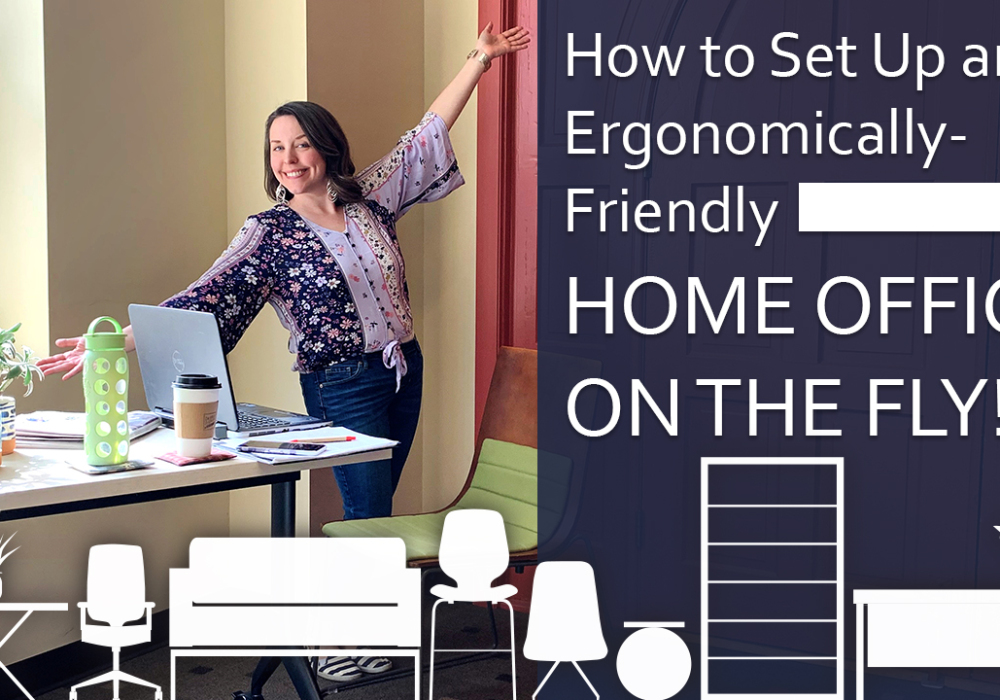How to Set Up an Ergonomically-Friendly Home Office on the Fly!
So, at the time this post is published, the coronavirus is making its way through our communities, and many of us are finding ourselves working from home. It’s no secret to workers that an ergonomically-friendly workspace is key to help us remain safe and healthy in any work environment. But what about when you’re working at home?
Not surprisingly, ergonomics are just as important at home as they are at work. The problem is many of us do not have furniture options at home that allow us to use them for long periods of time without risking injuries common in an office environment, like back pain, carpal tunnel, ganglion cysts, and more.
Sometimes we just have to do the best we can with what we have available to us. So as the Certified Office Ergonomics Evaluator at Benjamin Roberts Office Interiors in Lancaster, I’m here to share with you a few tips to create the most ergonomically-friendly workspace possible at home as we wait for the green light to return to our workplaces. Check out the video on YouTube, or read, below, to get started!

Tip #1 – The Right Chair
Scour your house for the most comfortable, supportive chair you can find, and use it. Proper posture when seated for long periods of time means that your feet are flat on the floor, with a 90-degree angle from your feet to your knees to your hips. You should be able to get two to three finger widths of space between the front of the seat of the chair and the back of your knees. You should be able to sit comfortably with your back fully supported by the back rest of the chair with a slightly open angle from your knees to your hips to your shoulders. If your chair has armrests, you want your forearms to be fully supported by the armrests – no leaning on your elbows. If you have an office chair at home, it may have some knobs, levers, or buttons under the seat or the armrests or on the back to help you adjust the chair until it is comfortable for you. Remember, do the best you can with what you have. You may need to use something for a foot rest or grab a pillow to help support your back. That’s OK – these are just temporary solutions, but they can help you feel better as you work.
Tip #2 – The Right Atmosphere
When you’re using a computer or filling out documents, natural light is best, so try to set up shop near a large window. If that’s not an option, use a variety of light sources, but make sure that your light does not shine directly on your computer monitor screen, or it could cause a glare that can damage your eyes over time. Natural light and a view to the outdoors can also help boost your mood, and with spring in the air, there’s a lot in nature to watch and enjoy.
Remember, our mental health is very important, too, especially in uncertain times, so creating an environment for yourself to work in that protects your physical body while also providing what you need to support your emotional and mental health can help make your workdays at home more enjoyable and productive. On that note, cue the coffee or tea in your favorite mug, fun or relaxing background music, some well-placed plants, and your pet asleep on the floor beside you – whatever you need to do to care for yourself and get work done, well!
Tip #3 – Get Moving!
Moving around throughout the day is the best thing you can do for your body. Try setting a box on your table or desk, if you don’t already have a height-adjustable worksurface. When using your computer while sitting or standing, you want the screen an arm’s length away and your eyes level with the top of the screen. You can also use a small box to raise the height of your keyboard, so that you have a comfortable 90 degree angle from your wrists to your elbows to your shoulders. Alternate between sitting, standing, and walking around regularly throughout the day – it will help support proper blood flow, which means important nutrients are getting to all of the different parts of your body. It can also help you feel more awake, alert, and focused, because, let’s face it, it can be hard to focus when you are working all day from home, especially if you’re not used to it.

So there you have it – some tips to help us all stay safe and healthy while working at home. Remember, these are just short-term solutions for working at home. We all need to do the best we can with what we have and see what great solutions we can come up with!
From all of us at Benjamin Roberts, stay healthy, safe, and joyful, today. Thanks!
ErgonomicsHome Office
